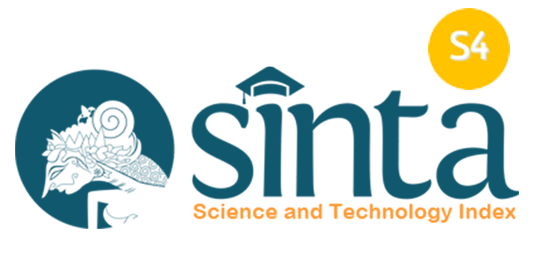The Effect of Educational Socialization Using Poster Media on Understanding the Proportion of Calories for Children
Abstract
Keywords
Full Text:
PDFReferences
Anggraheni, Y. N., and Saifuddin, M. F. (2021). Students’ perception of learning media poster material structure and function of plants for class VIII SMP. Journal of Biology Education Research, 2(2), 68-73.
Arraniri, M., Desmawati, D., and Aprilia, D. (2017). Hubungan kebiasaan sarapan dan asupan kalori dengan persentase lemak tubuh pada mahasiswa prodi profesi dokter fakultas kedokteran universitas andalas angkatan 2013-2015. Jurnal Kesehatan Andalas, 6(2), 265-270.
Asih, L. D., and Widyastiti, M. (2016). Meminimumkan jumlah kalori di dalam tubuh dengan memperhitungkan asupan makanan dan aktivitas menggunakan linear programming. Ekologia, 16(1), 38-44.
Farell, G., Ambiyar, A., Simatupang, W., Giatman, M., and Syahril, S. (2021). Analisis efektivitas pembelajaran daring pada smk dengan metode asynchronous dan synchronous. Edukatif: Jurnal Ilmu Pendidikan, 3(4), 1185-1190.
Fitriyanti, A. D. (2013). Aplikasi penghitung kalori terbakar saat berolahraga sepeda menggunakan global positioning system (gps) berbasis android. Jurnal Teknologi Informasi: Teori, Konsep, dan Implementasi, 4(2), 1-16.
Ichsan, B., Wibowo, B. H., and Sidiq, M. N. (2015). Penyuluhan pentingnya sayuran bagi anak-anak di TK Aisyiyah kwadungan, trowangsan, malangjiwan, Colomadu, Karanganyar, Jawa Tengah. Warta LPM, 18(1), 29-35.
John, I., Snapp, S., Nord, A., Chimonyo, V., Gwenambira, C., and Chikowo, R. (2021). Marginal more than mesic sites benefit from groundnut diversification of maize: Increased yield, protein, stability, and profits. Agriculture, Ecosystems and Environment, 320, 107585.
Khastini, R. O., Maryani, N., Wahyuni, I., Leksono, S. M., and Lantafi, N. P. T. (2021). Assisting student knowledge and critical thinking by e-learning media: post-harvest fungi poster. Cypriot Journal of Educational Science, 16(4), 1479-1491.
Leonita, E., and Nopriadi, N. (2010). Persepsi ibu terhadap obesitas pada anak sekolah dasar. Jurnal Kesehatan Komunitas, 1(1), 39-48.
Musa, M., Shah, N. S. M., Rosli, N. S., and Ibrahim, S. N. N. (2021). Kesedaran ibu bapa terhadap amalan pemakanan seimbang terhadap anak-anak. Selangor Humaniora Review, 5(1), 251-259.
Permanasari, Y., and Aditianti, A. (2018). Konsumsi makanan tinggi kalori dan lemak tetapi rendah serat dan aktivitas fisik kaitannya dengan kegemukan pada anak usia 5–18 tahun di Indonesia. Nutrition and Food Research, 40(2), 95-104.
Probowati, R., Ratnawati, M., and Prihatini, M. S. (2021). Pendampingan penanganan ibu hamil kekurangan energi kalori (kek) mencegah stunting di masa pandemi desa bareng kabupaten jombang: assistance in handling pregnant women with calorie energy deficiency (kek) preventing stunting during the pandemic period in bareng village, Jombang Regency. Jurnal Pengabdian Masyarakat Kesehatan, 7(2), 150-155.
Putri, Y. A., and Riski, S. (2020). Implementasi peraturan pemerintah no 23 tahun 2018 bagi pelaku usaha mikro kecil dan menengah (UMKM) sebagai upaya peningkatan kesadaran dan kepatuhan terhadap kewajiban perpajakan di kota Payakumbuh. Ekonomi Bisnis, 26(2), 411-418.
Rahmi, P. (2019). Peran nutrisi bagi tumbuh dan kembang anak usia dini. Jurnal Pendidikan Anak Bunayya, 5(1), 1-13.
Retnaningsih, C. H., and Putra, B. S. (2011). Penilaian status gizi berdasarkan kecukupan energi (kalori) dan protein pada balita (usia 3–5 tahun) di Desa Gogik Kecamatan Ungaran Barat Kabupaten Semarang. Seri Kajian Ilmiah, 14(2), 147-154.
Rosalina, S., and Istiqomah, S. B. T. (2018). Hubungan asupan kalori dan protein ibu nifas dengan lama penyembuhan luka perineum di puskesmas balowerti kota Kediri Indonesia. Jurnal Edumidwifery, 1(2), 87-95.
Sartika, R. A. D. (2011). Faktor risiko obesitas pada anak 5-15 tahun di Indonesia. Makara kesehatan, 15(1), 37-43.
Supangat, S., Amna, A. R., and Rahmawati, T. (2018). Implementasi decision tree C4. 5 untuk menentukan status berat badan dan kebutuhan energi pada anak usia 7-12 tahun. Teknika, 7(2), 73-78.
Suryani, A. D., and Ardian, Q. J. (2020). Rancang bangun identifikasi kebutuhan kalori dengan aplikasi go healthy life. Jurnal Teknologi Dan Sistem Informasi, 1(1), 47-56.
Swaninda, A., and Metty, I. T. (2021). Kadar gula total pada cokelat hitam ikan nila rendah kalori sebagai alternatif snack rendah kalori bagi remaja obesitas. Prosiding Seminar Nasional Multidisiplin Ilmu, 3(1), 244-248.
DOI: https://doi.org/10.17509/ajsee.v4i1.49774
Refbacks
- There are currently no refbacks.
Copyright (c) 2022 Universitas Pendidikan Indonesia

This work is licensed under a Creative Commons Attribution-ShareAlike 4.0 International License.














